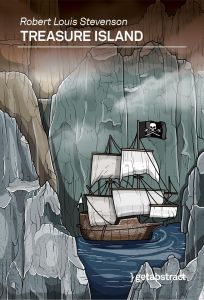
Treasure Island
- Adventure story
- Victorian literature
What It’s About
Going on an Adventure
Treasure Island offers everything an adventurer could want: a mysterious old sailor seeking refuge in a remote inn, a one-legged pirate with a parrot in search of the sailor, a treasure map that falls into the hands of a young boy and the dangerous journey across the sea to an island in search of the treasure, only to find that the crew has been infiltrated by a group of mutinous cronies and their one-legged leader. It taps into – and to some extent borrows from – a rich tradition of American novelists, including works by James Fennimore Cooper, Mark Twain and Washington Irving. Robert Louis Stevenson’s Treasure Island is an adventure story par excellence and while it was originally aimed at a young (and mainly male) readership, it has captured the hearts and minds of many an older reader as well. And no wonder – its iconic characters, like the brave but often rash teenage hero Jim Hawkins and the deeply immoral but often surprisingly likable pirate (and murderer) Long John Silver, the story’s characters draw you in and make you care about their fate.
Summary
About the Author
Robert Louis Stevenson was born in Edinburgh on November 13, 1850, the only son of his middle-class parents. His mother was deeply religious, so Stevenson grew up within a strict Presbyterian environment. His father was a successful engineer, best known for the many lighthouses he built, and the son was expected to follow in his footsteps. Stevenson initially studied engineering but was finally allowed to move into law. However, he soon began exploring French literature, then Sottish history and the works of Charles Darwin. Stevenson’s dislike of strict religiosity led to clashes with his parents. In his early 20s, he was diagnosed with tuberculosis, a severe respiratory illness from which he would suffer for the rest of his life. During that time, he also met – and fell in love with – Fanny Vandergrift Osbourne, an American woman who was married and ten years his senior. In 1879, he traveled to California to marry her after her divorce. Stevenson began his writing career initially as a travel writer and essayist. A collection of his short stories was published as The New Arabian Nights in 1882, but it was the success of his first full novel, Treasure Island, published in 1883 and followed by Kidnapped, that established him as an author and allowed him to live off his earnings. His strict religious upbringing and the question of evil and predestination influenced some of his later novels, most notably Strange Case of Dr Jekyll and Mr Hyde (1886) and The Master of Ballantrae (1889). After his father’s death in 1887, Stevenson moved to America for a year before setting off to the South Seas in 1888. He bought a property in Apia on Samoa as he was convinced that he wouldn’t survive another cold and wet winter in Britain and lived there from 1890. He wrote several travelogues and reports about life on the island – but no further major novels. At the time of his death, he was working on The Weir of Hermiston, a romantic historical novel that was markedly different in style from his previous work and has often been praised as having all the signs of a literary masterpiece. However, before he could finish the novel, Stevenson died of a cerebral hemorrhage at age 44 on December 3, 1894.








Comment on this summary